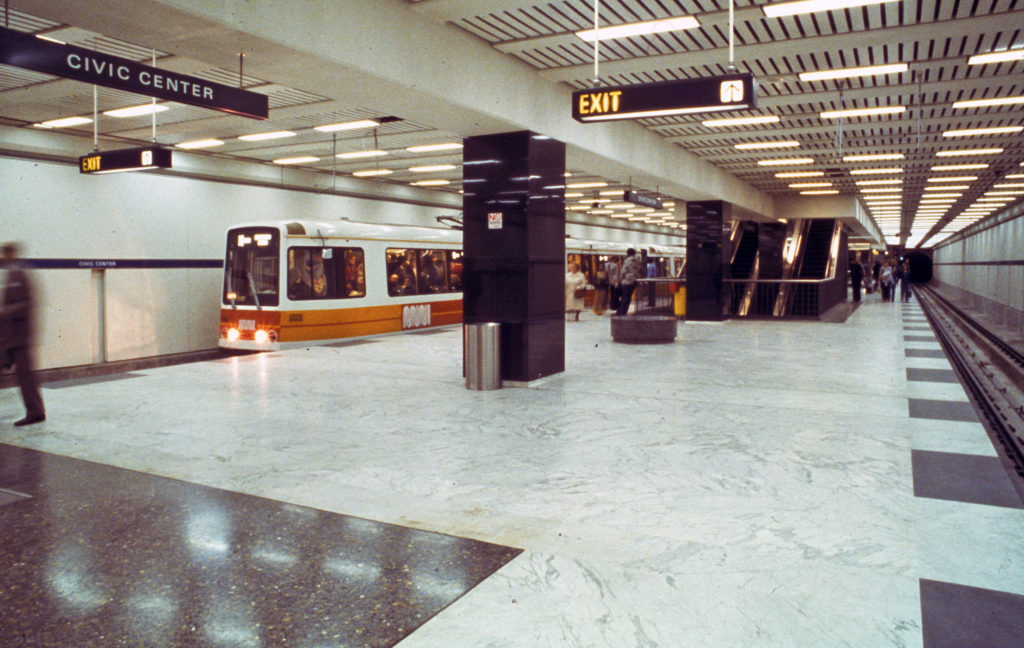
The idea of a transit subway under Market Street goes back to the first years of the 20th century, but it took more than 70 fitful years to become reality. That’s a complex and fascinating story we tell in this companion post, which explains the compromises that harmed Muni’s subway operation from the get-go.
The subway that finally got built has two levels between the Ferry Building and Van Ness Avenue, with regional BART trains running beneath Muni light rail vehicles (LRVs). Under Muni’s Van Ness station, BART trains turn south to continue under Mission Street, while the Muni subway continues west under Market to connect to the Twin Peaks Tunnel just west of Castro Street. In passing the 1962 bond issue that built BART and the Market Street subway, voters were told all five existing streetcar lines would use the subway.
In 1966, after warnings from an expert team that the subway would not function well with all five streetcar lines merging into it, San Francisco voters were asked to approve a true rapid transit subway, extended to San Francisco State College (now University), with high-platform trains like New York used. The other streetcar lines would become connector buses, feeding the subway. The $96.5 bond issue to pay for it was approved by 58% of voters, but it needed 2/3 to pass. That sealed a decision that has led to 40 years of challenges and frustrations in operating the Muni Metro Subway. That’s what this story is about.
The Latest Challenge
Muni Metro faced its biggest challenge with the Covid pandemic, starting in the spring of 2020. Completely shut down, along with all Muni rail service and most bus lines at that time, the subway reopened on a limited basis in August 2020, only to shut again three days later when the overhead failed. Muni replaced all the splices in the overhead and finally opened again in mid-2021, again on a limited basis. During the shutdown, Muni discovered numerous problems with subway infrastructure that they say will likely require further shutdowns over the next five to eight years to remedy.
Meanwhile, every other urban rail subway system in North America has either operated continuously through the Covid-19 crisis, or resumed operation after a brief shutdown. This includes the light rail subway-surface systems most akin to San Francisco’s, in Boston and Philadelphia, which opened in 1897 and 1906 respectively.
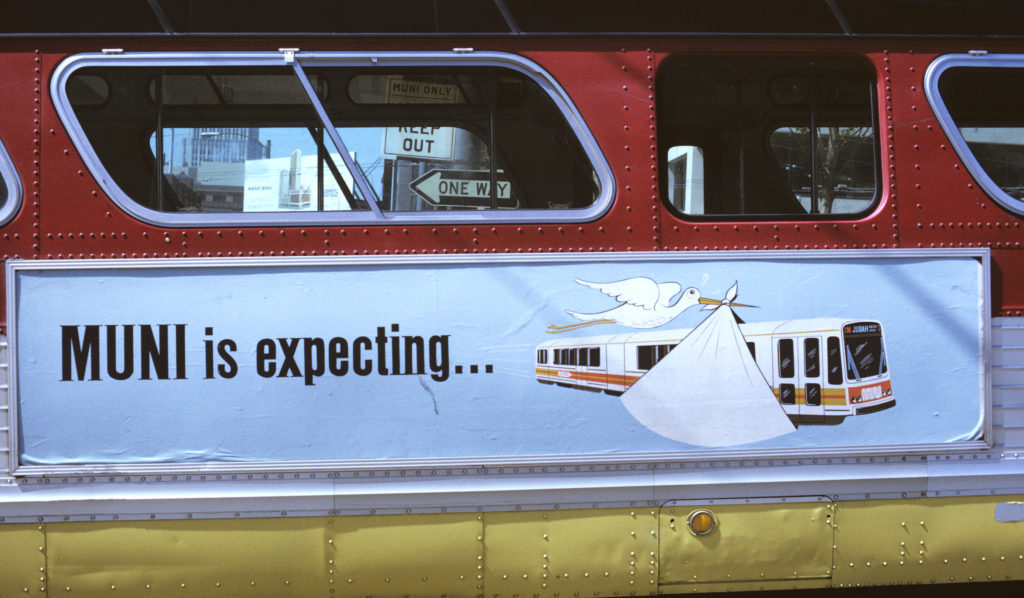
Coping with Covid is the newest chapter in the checkered history of a transit facility that opened on February 18, 1980, promising fast, reliable underground service to replace the aging, smaller “PCC” streetcars on Market Street.
Of course, thanks to Mayor Dianne Feinstein and many advocates, including Market Street Railway’s current leaders, fully-renovated PCCs again because part of the San Francisco scene, gaining great popularity providing reliable service on the surface of Market Street and waterfront streets on the F-line.
Meanwhile, Muni Metro has faltered repeatedly over its four decades of service under ten different top Muni bosses. Perhaps that unfortunate track record will be improved by this latest attempt to fix it. And as we will see, it’s possible historic streetcars on the surface might help the subway beneath run better in years to come.
Trying to make it work
The shiny new Muni Metro subway beneath Market Street opened to passengers on its first line, the N-Judah, on February 18, 1980. In our companion story, we recounted the 60-year effort to build the subway. By piggybacking on the BART project (literally, since Muni Metro sits directly above the regional BART subway from Embarcadero to Civic Center stations), that vision finally became reality.
The Muni Metro subway was phased into service a line at a time, starting with the N, using shiny new Boeing-Vertol light rail vehicles (LRVs). The other streetcar lines, the J, K, L, and M, gradually transitioned into the subway under Market Street, with full seven-day, five-line subway operation not commencing until some 30 months later. West of the subway, they continued on the surface tracks previously used by the PCC streetcars. The Twin Peaks Tunnel, opened in 1918, was tied into the subway at Castro Street; temporary ramps allowed the K, L, and M PCCs to keep using the tunnel until the subway was fully opened. (The “temporary” ramps are still there ostensibly for emergency use.)
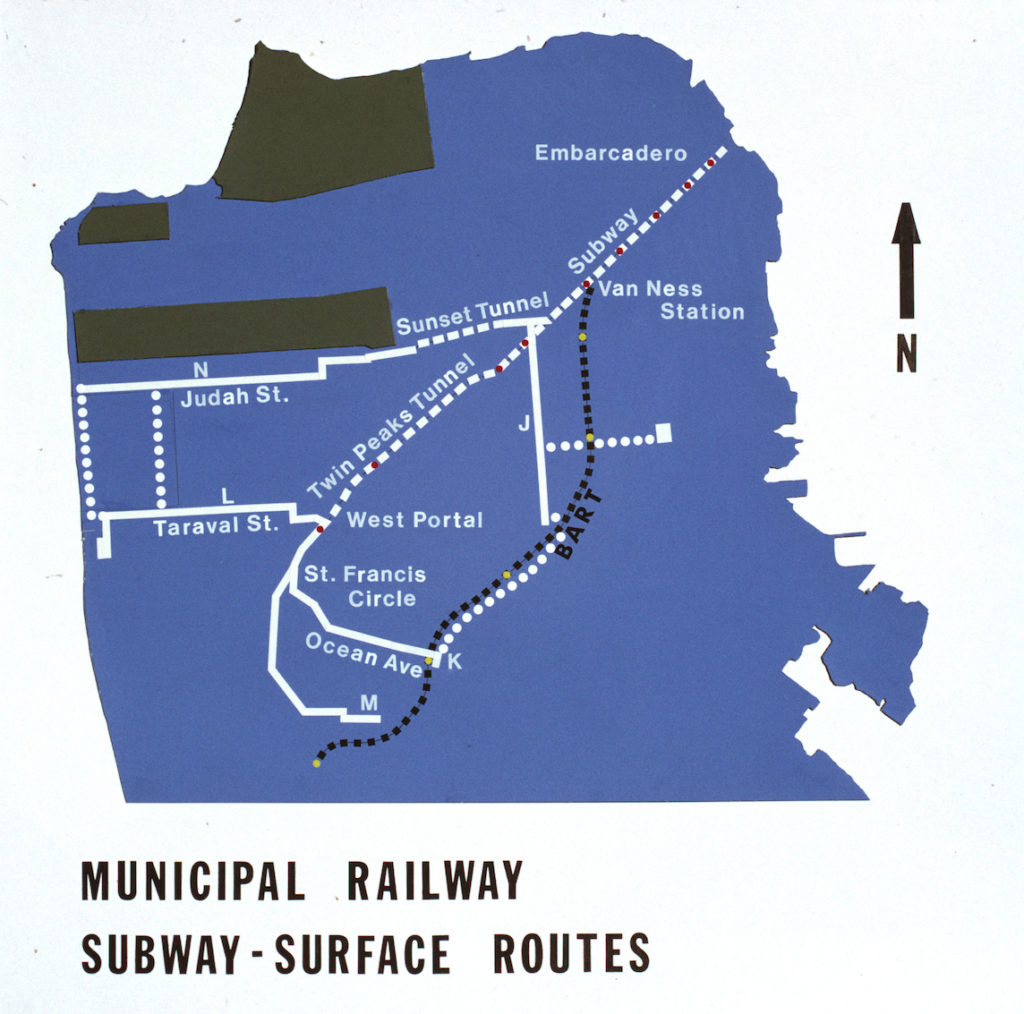
Even before the subway opened, Muni management knew it had a major problem. Every LRV leaving its home next to the Balboa Park BART station could only get to the subway by going over the K-Ingleside line, subject to traffic delays on narrow Ocean Avenue. While there were low-speed crossovers at Van Ness Station that would have allowed J and N trains to avoid going all the way to Embarcadero Station to turn around, these did not function well and delayed other trains in the subway.
As shown in the map above, Muni tried in the 1970s to win public approval of a connection between the L and N lines across the Sunset District to shorten the time (and reduce the labor costs) of getting the trains on its busiest line, the N, out to Ocean Beach to start their runs. But neighborhood opposition defeated that plan. These pull-out J and N trains in the subway added to its poor operational record for more than a decade, until Muni managed to get an extension of the J-line to Balboa Park approved, funded, and built by the early 1990s.
Both J and N LRVs entering and leaving service began using the extension in 1991, with the N cars turning west at Duboce and Church to reach Ocean Beach. Muni did not initially allow passengers to ride along the extension, as it was sandwiched between BART and Muni’s well-served Mission Street corridor, but federal officials, who held the pursestrings, demanded it, and it began carrying passengers in 1993. (When the F-line opened in 1995, its streetcars also began using the J-line to enter and leave service.) The J-line extension is today one of the least-ridden stretches of Muni light rail service, along with the outer end of the M-line, which was likewise extended along San Jose Avenue from its traditional terminal and Broad and Plymouth Streets to facilitate pull-outs and pull-ins and avoid using increasingly congested Ocean Avenue for that purpose. Though little-ridden by passengers, these extensions eased what would have been crippling subway congestion at peak periods by allowing LRVs entering service to avoid a trip all the way to Embarcadero Station just to turn around.
The initial operating plan was to couple LRVs from different lines at the subway portals (K,L, and M cars at West Portal, J and N cars at Church and Duboce). Muni knew that efficient coupling at the portals required the cars from the different lines to get there on schedule. To that end, they constructed a raised right-of-way for the N-line on Judah between Ninth and 19th Avenues, with the goal of extending it to the end of the line at Ocean Beach, and then following up with similar treatments on the outer ends of other lines. But neighbors on that first stretch of Judah complained bitterly of difficulty accessing their driveways, blunting extensions of the special treatment farther west. It took decades for streetcar priority measures to move forward, fitfully, along the lines.
Fighting street traffic often meant schedules weren’t kept, which meant one line’s streetcar would arrive at the subway portal and be forced to wait for the other cars so that a train could be assembled. Riders on the first car would get restless. Inspectors on the scene were instructed to dispatch the first car if its mates hadn’t arrived within two minutes. That single car was thus taking up a slot in the subway intended for two, three, or four cars. The original automatic train control system enforced distance between trains, so losing a coupling opportunity pushed everything back, lengthening waits at the portals. (In PCC days, the Twin Peaks Tunnel had used simpler block signals, which Boston still does, successfully, to this day. Block signals do, however, decrease the train capacity of a subway somewhat.)
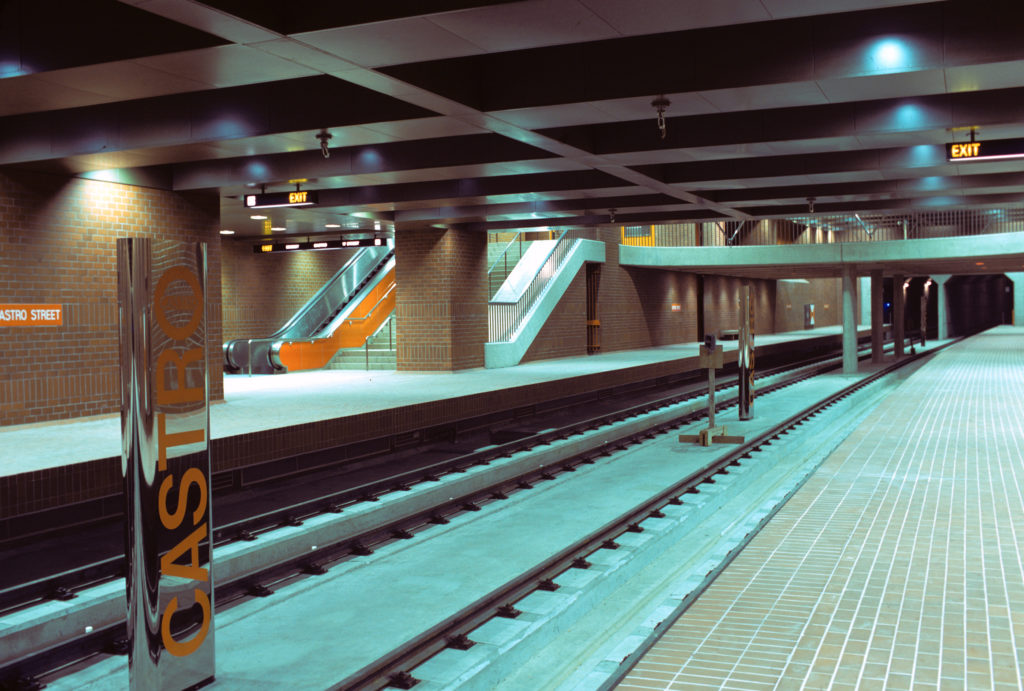
At the other end of the subway, the two-track stub terminal at Embarcadero Station was woefully inadequate. Planners called for a train to depart every two minutes, but operators in each car had to change ends and power up. Given the limitations of some of the LRVs’ systems, that proved unworkable. If an operator needed a bathroom break, it got worse.
To speed up the turnaround, Muni tried having crews “fall back.” A relief crew would board an inbound train at Montgomery Station and be ready to activate the cabs on the other ends of the train cars as soon as they reached Embarcadero Station. The crew that brought the train inbound would stay on outbound until they got back to Montgomery, there getting off to join a “pool” of operators waiting for more inbound trains. But the trains were different lengths, and assigned to different routes. It did not work well, leading Muni to abandon the coupling plan altogether and simply feed single cars (or on the busiest lines, already-coupled two-car trains) into the subway as they arrived at the portals.
The Boeing cars proved notoriously unreliable and maintenance-intensive in both San Francisco and Boston, far more than the PCCs they replaced. Boston had gotten its Boeing LRVs first and was furious with the poor quality, cannibalizing 35 cars for parts and refusing the final 40 cars in their order. In San Francisco, the failure of the portal coupling to work as anticipated effectively lowered subway capacity, which meant Muni didn’t have enough LRVs to meet demand. With no near-term alternative available, Muni bought 30 of Boston’s unwanted Boeings and had them modified. (When they were finally retired, the extreme unreliability of the Boeings made Muni management unwilling to restore any for the heritage fleet.)
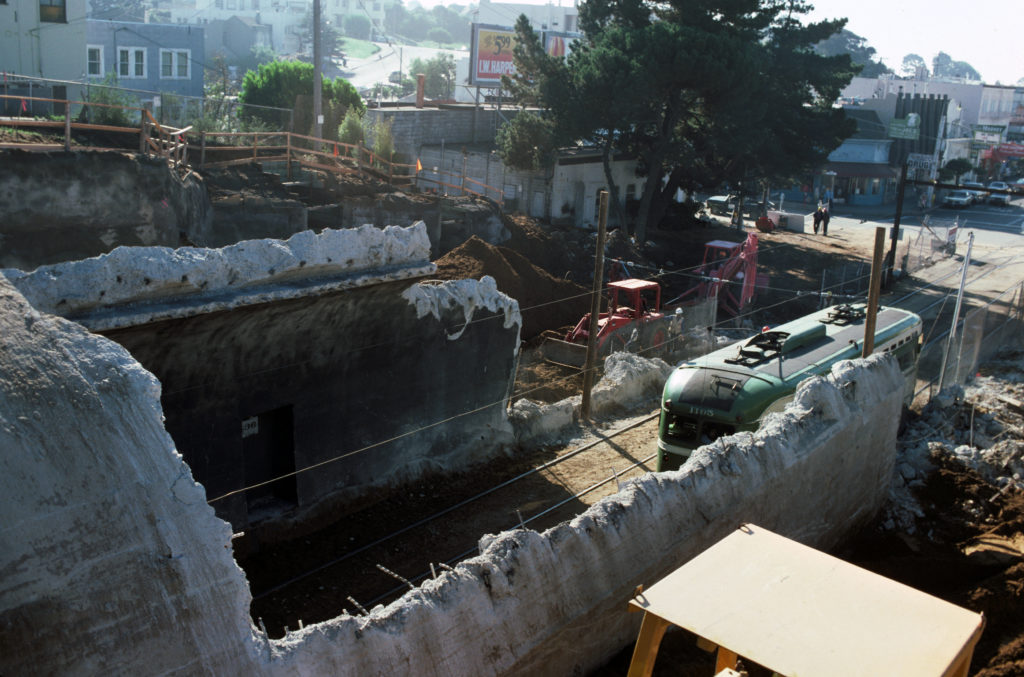
For a while, to minimize on-street Boeing breakdowns, Muni tried uncoupling the second car of two-car trains at outer terminals after the morning rush hour and sending the extra cars back to the barn, to come back for evening rush. This reduced the service hours of the fleet, but was logistically complicated and didn’t last long.
Even after coupling in service was discontinued, the subway was backed up more often than not at its eastern end, because of the stub-end bottleneck at Embarcadero Station. Regular commuters whose offices were near Embarcadero Station would ask themselves every day (like Clint Eastwood’s Dirty Harry), “Do I feel lucky?” as they approached Powell Street Station, often opting to walk the rest of the way unless it was raining. The slow turnaround constrained capacity in the evening peak as well. Riders at Montgomery and Powell stations heading outbound (west) would often board trains going the other direction, ride to the terminal at Embarcadero and come back the other way, so they could get a seat or even a place to stand on the jammed trains.
Muni Metro turnaround
Muni moved to address these problems by reviving the idea of an underground loop, but it was a daunting engineering task, since BART was already built and operating just six feet below, and the ground east of Embarcadero Station was below the water table and riddled with old shipwrecks. Deputy Mayor Doug Wright (later chair of Market Street Railway’s board of directors until his passing in 2014) spearheaded a move to bring some of the trains to the surface on the Embarcadero, three blocks south of Market, and turn others in pocket tracks along the way, minimizing the footprint of the work and getting it away from the BART tubes as quickly as possible. This reduced the number of trains reversing at Embarcadero Station while offering the considerable extra benefit of providing LRV service along the sleepy southern Embarcadero, spurring a frenzy of development that included thousands of residential units and a new ballpark for the Giants. The “Muni Metro Turnback Project,” which ended up costing more than $200 million, fully opened in 1998.
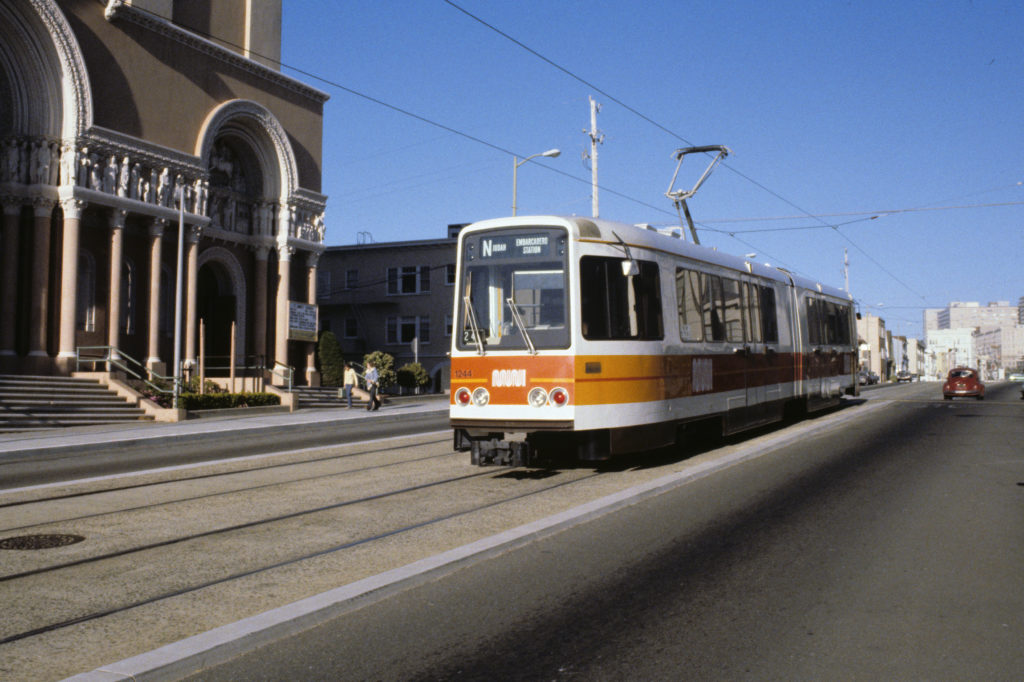
At this point, having won permission from the Feds to retire the troublesome Boeing cars early, Muni was in the midst of a transition to LRVs designed expressly for San Francisco by Ansaldo Breda of Italy. This was coupled with installation of a new “moving block” automatic train control system (ATCS) intended to boost subway capacity.
Both projects were fraught with problems. The ATCS system was unreliable and incompatible with the Boeing cars, which were supposed to be retired by the changeover but couldn’t be because of problems with the Breda order. (Many of the Boeings had to be expensively retrofitted to keep operating.) The Breda cars were also far heavier than the Boeings, forcing earlier-than-planned replacement of surface tracks and garnering complaints from neighbors about their noise and vibration. To top it off, they were not significantly more reliable than the Boeing cars, and needed multiple upgrades and retrofits throughout their lives.
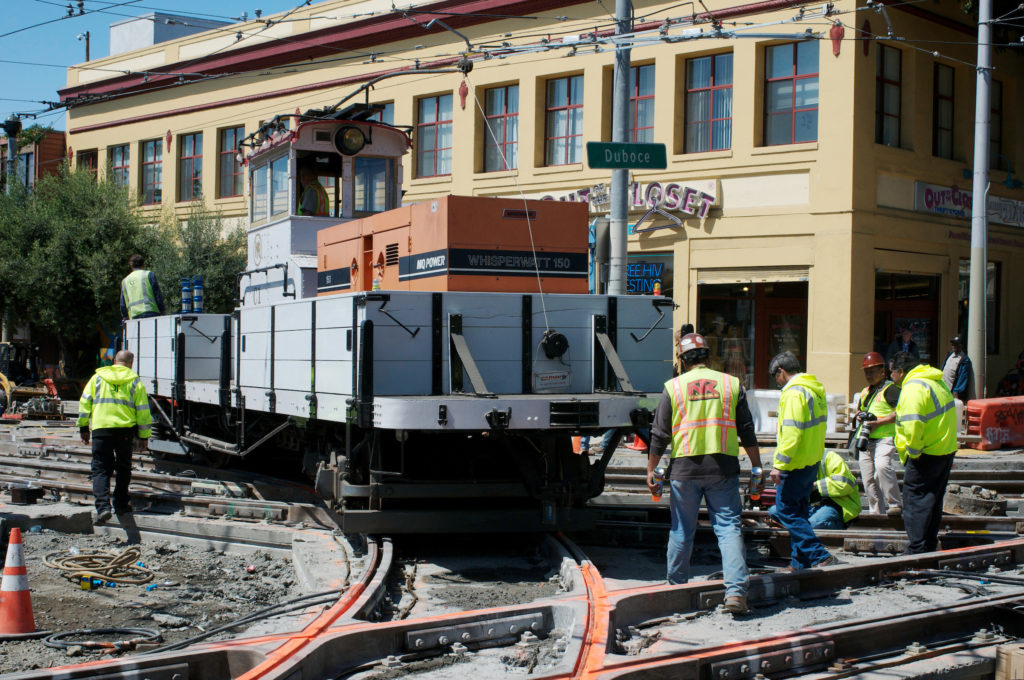
The first day of the new ATCS system and full use of the Muni Metro turnback, in 1998, was a spectacular and total failure, dubbed the “Muni Metro Meltdown” by the press. Subway service gridlocked, leaving passengers to force open doors in mid-tunnel to escape. Serious subway problems persisted for days and have lingered on and off ever since. Periodic electrical and mechanical failures such as stuck switches and downed overhead wires have stopped the subway cold numerous times, reviving the “Muni Metro Meltdown” tag. (One recent one, in 2019, is said to have caused Mayor London Breed to eject SFMTA head Ed Reiskin, and downed subway wires aborted the subway restart early in the tenure of his successor, Jeff Tumlin.)
As if having five lines jammed into a subway weren’t enough, Muni added a new one, the T-Third, in 2007. It was routed into the Market Street Subway at the Embarcadero Portal until the new Central Subway, running north-south under Fourth and Stockton Streets, opens. That was supposed to happen in late 2018, but it’s now more than three years late.
Initially, Muni tried terminating T-line trains at Castro Station using a crossover there. The idea was to give subway riders more trains through the most heavily used part of the subway. But Muni could not make it work operationally, delaying other trains in both directions as the T-trains switched back. In less than three months, Muni gave up on the Castro terminal idea and combined the T line with the venerable K-Ingleside, creating its longest streetcar route since the old interurban 40-line to San Mateo was abandoned in 1949, stretching more than fifteen miles from the city’s southeastern corner to the Balboa Park BART Station in a giant fishhook-shaped route. (The two terminals of the KT-line are less than three miles apart via Geneva Avenue.) This exceedingly long line led to more erratic arrival times at the tunnel portals (the T shares the portal at Folsom and the Embarcadero with the N-Judah), but at least it eliminated switching back in the subway itself, which Muni has always had trouble making work.
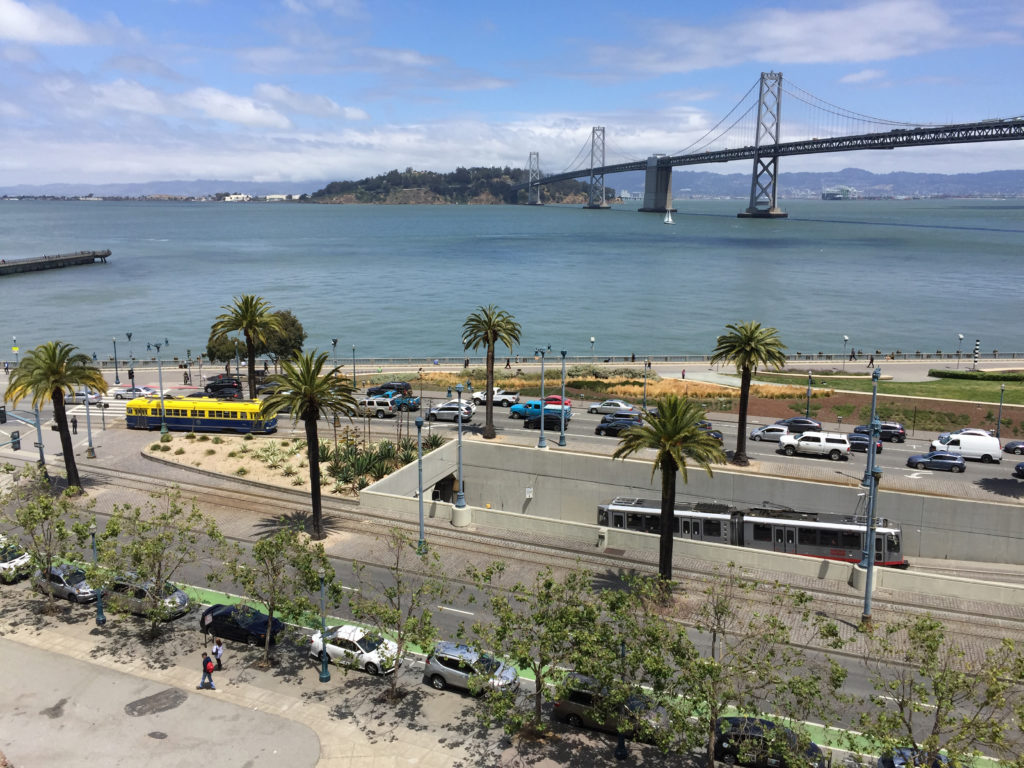
The persistent congestion in the subway led to many trains stopping in the tunnel between stations during rush hours in particular, since the ATCS only allowed one train to stop in a given station at a time. But the downtown stations, built to BART platform lengths, could easily accommodate two trains at once. In the mid-2010s then-Muni head John Haley promised to institute two-train simultaneous stops to mollify outraged passengers repeatedly stuck in the tunnels, but Haley could not get it to work reliably.
Will less be more?
Throughout the 40 years of Muni Metro history, some armchair transit wonks, as well as actual professional planners, have been insisting that the core problem is that even five lines trying to use the same subway is at least two too many, although several cities in Europe have arrangements like this that work effectively. The most common recommendation of these folks is to take at least the J and K lines out of the subway, and maybe the L as well, leaving the highest ridership M and N lines underground.
That approach is precisely what Muni implemented on August 22, 2020, when they tried to restart the subway. LRVs on the J-line turned back on the surface at Church and Market, with riders told to transfer to the remaining subway lines at Church Street Station below. Riders on the outer ends of the K and L were forced to do the same at West Portal, with those trains interlined as the KL all-surface operation between the Zoo and Balboa Park. To avoid trying to turn the T-line around in the subway again, it was interlined with the M-line, an even longer route than the old KT. The MT and the N lines, both running two-car trains, were joined in the slimmed down subway by a new S-Shuttle line, operating in the subway between Embarcadero Station and West Portal Station. The S was slated to eventually have three car trains, to accommodate riders transferring from the J, K, and L surface lines.
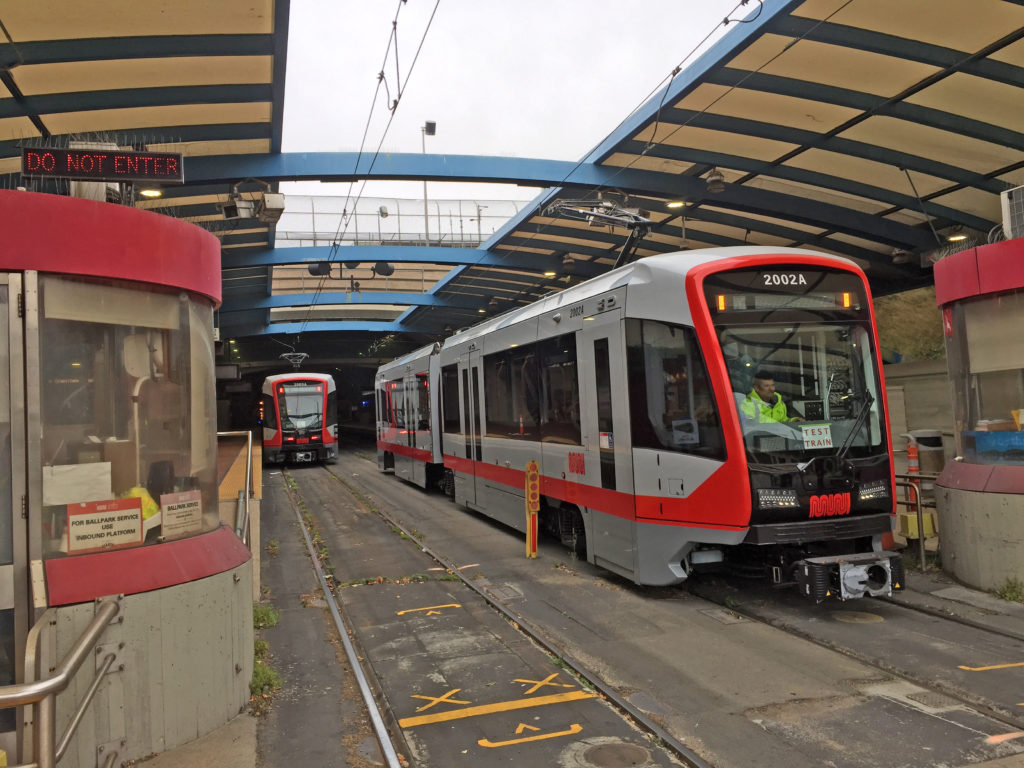
This brave new subway world fell apart after just a weekend of operation when overhead wires started to come down in the subway, and an operations center worker tested positive for Covid-19, forcing a quarantine of other key personnel. Muni scrambled to restore bus service on the lines, and the subway stayed closed until May 15, 2021, more than a full year after its initial shutdown. Meantime, riders continued to pile on buses for surface rides.
When the subway did reopen, it was with the N, the M and a reconnected KT, plus intermittent shuttles. The L remained a bus running over Twin Peaks and down Market Street, a function of a four-year rebuilding of Taraval Street, not scheduled to be finished until 2024. The J remained as a shortened surface LRV (light rail) line to Duboce and Church, causing frustration among some J-line riders who hated the forced transfer and wanted their single-seat ride to downtown back.
SFMTA leadership, including top boss Jeff Tumlin and Muni’s top official Julie Kirschbaum, are committed to keep trying to improve the subway. They are trying to fund replacement of the current, badly flawed, second-generation automatic train control system (ATCS) to increase capacity and reliability, but if the past is prologue, completion of such a system could be at least ten years down the road.
Even with that, they deeply believe that the inherent shortcomings of the subway they (and several generations of leaders before them) inherited can best be mitigated by keeping the J on the surface, and they said so to their board of directors on December 7, 2021. But an organized group of J-line riders and transit activists flooded the public comment period of the meeting with passionate calls to put the J-line back in the subway, and that — for now — is what the board decided to do. At the same time, board members showed enthusiasm for a possible future conversion of the J-line to historic streetcars, as a way to maintain that single-seat ride while keeping the subway unclogged.
Can PCCs play a role on the J?
Muni’s oldest surviving streetcar line, opened in 1917, the J used PCC streetcars exclusively from 1957 to 1982. And not just then. During the Historic Trolley Festivals of the 1980s, PCCs occasionally ran along the J to its then 30th Street terminal. Later, one month after the permanent F-line opened, in October 1995, Muni shut the Market Street Subway down at 10:00pm to facilitate installation of the second generation automatic train control system. (Despite the early start every night, the job still took three years.) Four lines got substitute buses for the last few hours of daily service, but the J-line used PCCs instead, sharing Market Street’s surface tracks with F-line cars. It was a successful substitution. And of course, PCCs operate along the surface portion of the J-line every day, on their way into and out of service on the F-line. And while they are on J-line trackage, they are in regular service to pick up and drop off passengers at any J-line stop (although most riders don’t know this and some operators — against the rules — still refuse to do it). So, PCCs are already at home on the J.
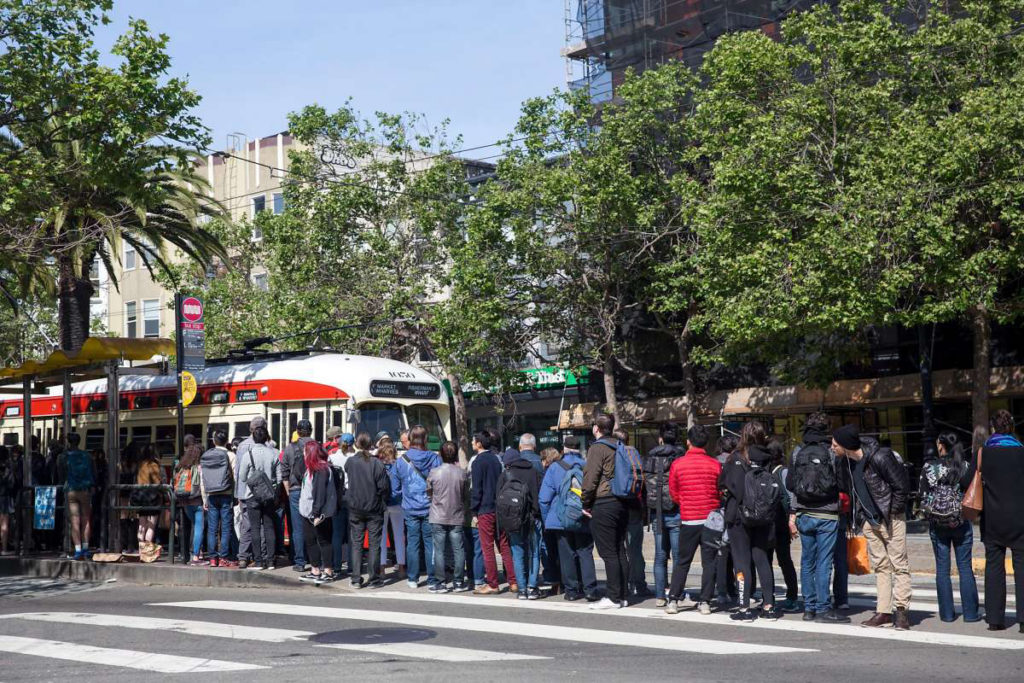
Extending the J-line downtown on the surface cannot be done with the LRVs, which use pantographs on their roofs to collect electric power from the overhead wires. These would foul the overhead on Market, which is set up for use with trolley poles, as Muni’s vintage streetcars have, as do its trolley buses. (It’s doubtful trolley poles could be installed on either the Breda or newer Siemens LRVs, given their roof configurations.)
Market Street Railway has been asking for a demonstration project using PCCs on a surface J-line for many years now, and the idea has attracted many enthusiastic adherents, including some on the SFMTA board, which directed management to study what’s needed to start up such a service. There’s no immediate plan to do so; the board made it clear that they want options in the event that putting the J back in the subway slows down service for the vast majority of subway riders who ride the other underground lines.
What’s to come?
No one knows how long it will take for ridership in the Muni Metro subway (or anywhere else on Bay Area transit) to return to pre-pandemic levels. In November 2021, the Muni system was carrying only half the daily passengers it carried in 2019. Many large downtown employers have told their workers they can work from home indefinitely, and some are giving up large chunks of their office space. Retail vacancy rates downtown are at historically high levels, driven by a combination of Covid and the accelerating gravitation toward online shopping. And as long as Covid infections and hospitalizations continue, some percentage of past transit riders will opt for the perceived security of their automobiles.
Yet the Market Street subway is a multi-billion dollar public asset. It would in all likelihood not be affordable to build today. The access it provides, the connections it enables, will foster new businesses and help fill up office and retail vacancies along the corridor it serves. In that way, it will be a key to San Francisco’s future vitality.
The current depressed ridership level actually gives Muni the opportunity to test different arrangements of its rail service and see what works best to meet the long-term needs of all San Franciscans – if some activists can get away from the mindset that routes and frequencies must be returned to exactly the way they were before the pandemic. Ridership patters definitely are different now, and in some areas at least they won’t snap back to the old days, just as parts of the City changed forever after the cataclysm of 1906.
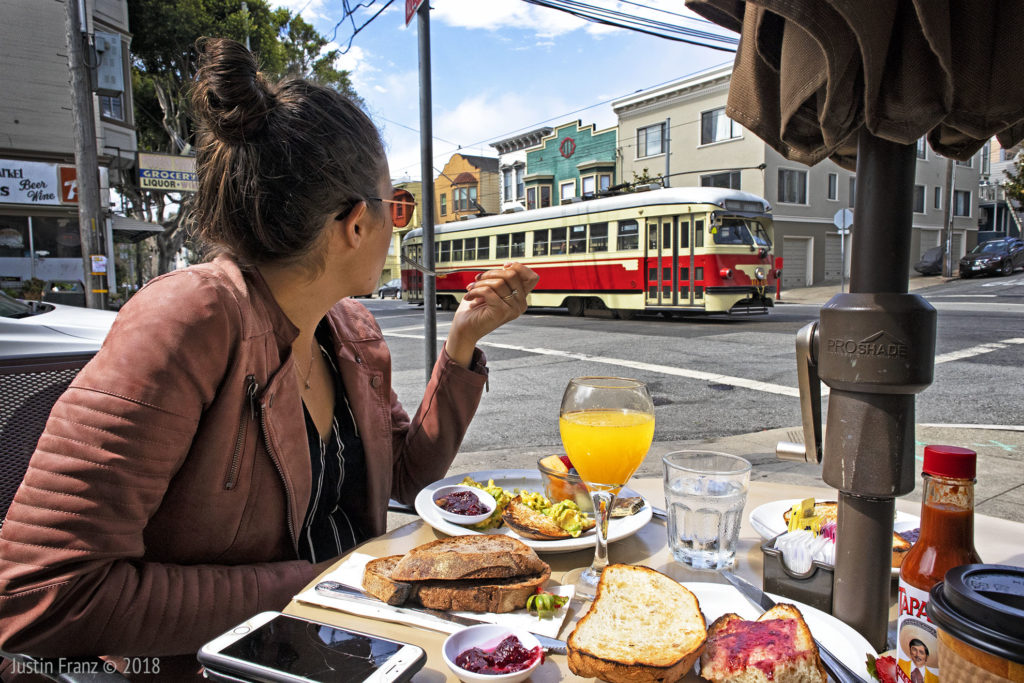
The decision of the SFMTA board of directors to return the J-line to full subway service with LRVs may work well, at least until the L-Taraval comes back as a rail line after the rebuilding of Taraval Street is finished. At that point, if the subway is back to its pre-pandemic pattern of delays and snarls, trying PCCs on the J makes a lot of sense. The other lines in the Muni Metro subway operate underground, free from traffic, for much greater distances than the J (the N through the Sunset Tunnel, the K, L, and M through the Twin Peaks Tunnel). Thus, replacing them with surface vehicles would greatly increase travel times for their riders.
By contrast, operating the J-line on the surface might actually be quicker for riders to many destinations along Market Street. What actually counts for people is total travel time, not just time spent on Muni vehicles. J-line surface streetcars would share the F-line stops, which are more frequent than subway stops. This allows riders to leave the streetcar closer to their actual destination in most cases, and avoids the need to climb up from the subway platform to a street entrance. With automobiles banned from Market Street east of Van Ness, Muni buses and F-line streetcars using Market have speeded up their trips considerably. All this means that J-line surface streetcars should be time-competitive at least as far east as Civic Center or Powell Street, and when the subway is jammed up, competitive in total travel time even to lower Market.
Competitive travel times along Market, and the popularity of the PCC streetcars, with their upholstered, forward-facing seats and timeless style, might help rebuild J-line ridership by providing an attractive public transit experience along the J-line.
As the Market Street Subway moves into the next phase of its existence, it’s definitely worth fully exploring this idea. After 40 years of failure trying to jam so many lines into a single subway, it may well be that less is more.
We at Market Street Railway not only work to preserve and support historic transit in San Francisco, we also research and write about how transit has shaped our city in the past – for better or worse – so that these lessons might be applied to make informed decisions for the future. We would appreciate it if you could join or donate to our nonprofit.
Fascinating article Rick, I wasn’t really aware of the engineering feat this has been…….
Very interesting reading this from the Bay State. San Francisco and Boston will forever be linked together by their public transit.
Re the black and blue light rail line map, the spur east from the J lines up with the 24th Street BART station dot; not sure how they’d navigate the steepest block of 24th near Guerrero which the original streetcars bypassed. Anyhow, assuming 24th Street is correct then the storage facility may have been the long, skinny block that now hosts the SF General parking garage, which used to be a MSR carbarn (per the 1936 aerial photo of SF).
Soon after the subway came into full operation, many were calling for the J Church to be put back on the surface, as five lines were just too many, and they could not get the J syncronized with any of the other lines, which, as is pointed out, forced the the first car to have to sit and wait for the second. With this argument now about 40 years old, its high time they they actually impliment it..
PS: Most of the PCCs used on the F line are NOT re-habbed MUNI cars.
Brilliant article, it answers so many questions I’ve had, on so many levels!. I’ll be referencing it when people ask (“When is the J going back into the subway?”) and pointing them to this article/website. We visited Boston again, two years ago, my first time to use their subway. I was thinking of how the Boeing cars were said to have their pointed ends to fit the tight curves in Boston, and how that left a gap at platforms in SF. The gap in Boston, for its current cars, (between the stairs and platform) is even worse, but it doesn’t seem to illicit any concern, there.
Great article. I wish more people would get a chance to read it. I know it would generate a ton of debate.
I love the idea of the J remaining a surface route especially if it can travel down Market Street to the Embarcadero. I also love the idea of running it with PCCs. What if, however, the overhead on Market Street were to be modified to allow both trolley pole and pantograph, much like the rest of the surface J line? I think allowing LRVs to use Market Street would be a good option as well.
The track lanes on Market Street have double overhead wires, so they can be used by both trolley buses and streetcars with trolley poles. Pantographs can’t run under this wire arrangement. The only feasible way to make that work would be to replace the current overhead with a single streetcar/LRV wire, with runners to guide pantographs through special work, with a separate two-wire trolley coach overhead outboard of the streetcar wire. That’s feasible, but very expensive. The City plans to replace the overhead as part of its Better Market Street Project, which is likely to take 20 or more years to complete. Also, one or two new substations would need to be built, as the LRVs draw a lot more power than streetcars or trolley buses. It’s all doable — just takes lots of $$$ and time. You should lobby SFMTA directly on this.
Rick and all, As the Siemens cars are still being delivered, it should be trivial to get a couple dozen built with poles for J surface usage. Store them all At Metro East. As to headways in the tunnel, I have said for years that fallback staffing @ Embarcadero can eliminate many delays IF coupled with abolishing actual route assignment (picks)in favor of dynamic resequencing outbounds. to maintain service on each route.. Having every route served as scheduled will lessen crowding both on platforms and trains. Furthermore, fallback should automatically allow bathroom breaks as a humane behavior. If one believes the Central Subway will ever open,, and the J reverts to surface all the way, there should be no excuse for inability to operate 4 routes decently. If Muni caan’t figure outheadways tighter than 2 minutes (Chicago Transit Authority acheived 90″ in the 1950s with “obsolete” hardwired wayside block signals) then at least the Ns, and Ms should all be 3 car trains if we ever experienve rush hour again.
Rereading this, I remain frustrated by the 5 lines can’t run in a tunnel trope. Count the lines under Market Street in Philadelphia,which IINM, are mere human operated as opposed to poorly performing computer systems . Of course they have a loop turnaround. “.
Now with the Central Subway, having removed the T from the mix surely Muni can be taught to make it work.. As to coupling/decoupling at the portals, should we believe a yard man position could fix the issue? If, this allows greater throughput we all win. The trailing train inbound person should clock off for a ten minute ‘break’ then work the next decoupling outbound trailing train.